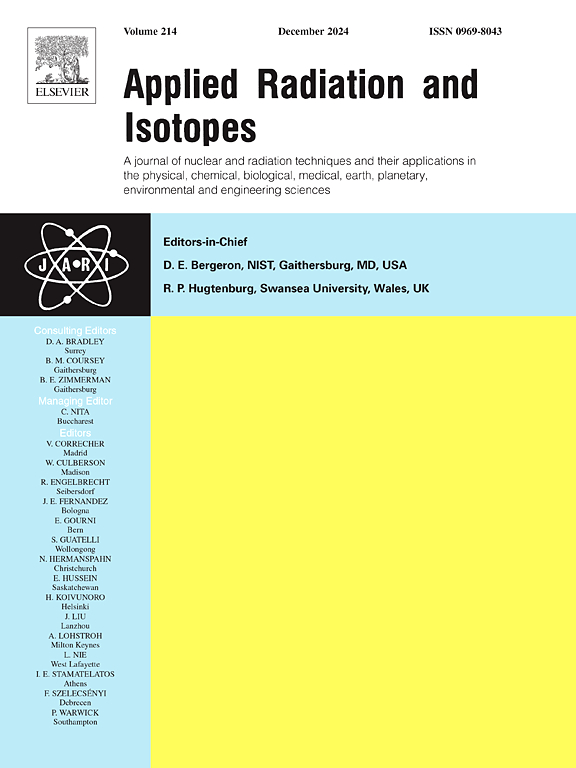Conceptual design of sandwich walls for shielding against secondary neutrons using MC simulations with FLUKA
IF 1.6
3区 工程技术
Q3 CHEMISTRY, INORGANIC & NUCLEAR
引用次数: 0
Abstract
FLUKA Monte-Carlo transport code was employed to evaluate the secondary neutron spectra emerging from spherical sandwich shielding configurations composed of concrete and soil, similar to that used at the particle therapy facility MedAustron. This study provides a comparative analysis of neutron spectra attenuated by a concrete-soil-concrete (CSC) sandwich wall shielding configuration versus a full concrete wall design (CCC). Furthermore, we enhanced the shielding performance of the CSC configuration by adding an additional concrete layer (CCSC) to achieve results comparable to the CCC shielding. Two scenarios were tested for shielding performance: (1) primary protons at 100 MeV, and (2) primary carbon ions (C-ions) at 190 MeV/u. Our simulations with primary protons of 100 MeV showed that adding additional internal concrete wall to the CSC configuration, therefore designing the CCSC configuration, the RP performance becomes slightly improved – the HE-peak drops from (1.43 ± 0.11)10−11 to (5.62 ± 0.3)10−12, about 2.5 times. Still, the HE-peak of the exiting neutron spectrum from CCC -(6.29 ± 1.87) 10−13 is about 9 times lower than that exiting CCSC - (5.62 ± 0.3) 10−12.
Our simulations with primary C-ions showed that by placing an additional internal concrete wall to the CSC configuration (CCSC) the RP performance becomes slightly improved – the exiting HE peak can be further attenuated from (6.92 ± 0.40)10−9 for CSC to (3.79 ± 0.15)10−9, becoming comparable to the one exiting the CCC configuration, (0.92 ± 0.04)10−9, only 4 times higher. Future research should be focused on improvements of the RP performance of the CCSC, by increasing the soil layer thickness and taking into consideration the humidity (water content) in the soil and concrete and also improve the number of primaries to 109 or even 1010 for better statistical outcome.
利用 FLUKA 进行 MC 模拟,设计用于屏蔽二次中子的夹层墙的概念设计
采用 FLUKA Monte-Carlo 传输代码评估了由混凝土和土壤组成的球形夹层屏蔽配置产生的二次中子能谱,该配置与粒子治疗设施 MedAustron 使用的配置类似。本研究对混凝土-土壤-混凝土(CSC)夹层屏蔽墙配置与全混凝土墙设计(CCC)衰减的中子能谱进行了比较分析。此外,我们还通过添加额外的混凝土层(CCSC)来增强 CSC 配置的屏蔽性能,以达到与 CCC 屏蔽相当的效果。我们测试了两种情况下的屏蔽性能:(1) 100 MeV 的初级质子;(2) 190 MeV/u 的初级碳离子 (C-离子)。我们对 100 MeV 的原生质子进行的模拟显示,在 CSC 配置中增加额外的内部混凝土墙,从而设计出 CCSC 配置,RP 性能略有改善--HE 峰值从 (1.43 ± 0.11)10-11 降至 (5.62 ± 0.3)10-12 约 2.5 倍。尽管如此,从 CCC 中流出的中子谱的 HE 峰值-(6.29 ± 1.87) 10-13 仍比从 CCSC 中流出的 HE 峰值-(5.62 ± 0.3) 10-12 低约 9 倍。92 ± 0.40)10-9 降至 (3.79 ± 0.15)10-9 ,与 CCC 配置的 (0.92 ± 0.04)10-9 值相当,仅高出 4 倍。未来研究的重点应是通过增加土层厚度、考虑土壤和混凝土中的湿度(含水量)以及将基元数增加到 109 甚至 1010 以获得更好的统计结果,从而改善 CCSC 的 RP 性能。
本文章由计算机程序翻译,如有差异,请以英文原文为准。
求助全文
约1分钟内获得全文
求助全文
来源期刊

Applied Radiation and Isotopes
工程技术-核科学技术
CiteScore
3.00
自引率
12.50%
发文量
406
审稿时长
13.5 months
期刊介绍:
Applied Radiation and Isotopes provides a high quality medium for the publication of substantial, original and scientific and technological papers on the development and peaceful application of nuclear, radiation and radionuclide techniques in chemistry, physics, biochemistry, biology, medicine, security, engineering and in the earth, planetary and environmental sciences, all including dosimetry. Nuclear techniques are defined in the broadest sense and both experimental and theoretical papers are welcome. They include the development and use of α- and β-particles, X-rays and γ-rays, neutrons and other nuclear particles and radiations from all sources, including radionuclides, synchrotron sources, cyclotrons and reactors and from the natural environment.
The journal aims to publish papers with significance to an international audience, containing substantial novelty and scientific impact. The Editors reserve the rights to reject, with or without external review, papers that do not meet these criteria.
Papers dealing with radiation processing, i.e., where radiation is used to bring about a biological, chemical or physical change in a material, should be directed to our sister journal Radiation Physics and Chemistry.
 求助内容:
求助内容: 应助结果提醒方式:
应助结果提醒方式:


